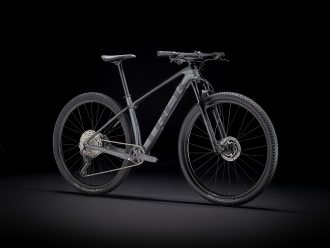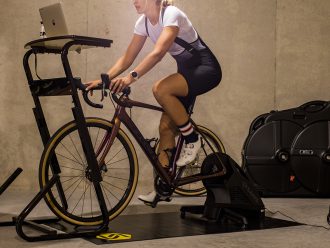Giving your bike a little TLC helps it run smoothly and reduces the chance that you’ll be caught off-guard by a maintenance mishap on the road or trail. These four simple how-to videos will walk you through the basics of caring for your bike.
Start with two buckets of warm water—one for your bike, and one for your drivetrain—and a hard-bristled brush, a soft-bristled brush, a cone brush, bike-specific degreaser, bike wash, a clean dry towel, and chain lube. You can put your bike in a stand, or lean it up against a wall.
Soak the drivetrain, frame, and wheels with a pre-wash of cleaning solution. Then spray the drivetrain with degreaser, carefully avoiding spraying directly into any bearings. Then, spray the frame, wheels, and tires with bike wash, again avoiding spraying into any bearings.
While the bike is soaking, fill two buckets with a few ounces of bike-specific degreaser and enough warm water to submerge your brushes.
Start with your drivetrain. Use the drivetrain bucket and hard-bristled brush to clean the entire drivetrain. You can also use a chain cleaning device filled with degreaser instead.
Next, wash the frame and fork from the top of the bike down using a soft-bristled brush with the clean bucket of degreaser solution. Clean the tires with a hard-bristled brush, the wheels with a soft-bristled brush, and use the cone brush for cleaning your hubs. When cleaning your wheels, avoid contacting the brake system to avoid any chance of contamination.
Once the entire bike is clean, rinse it with a light shower spray. Finally, wipe down the frame with a clean soft towel until dry and add lube to the chain.
Wear clothes you don’t mind getting dirty! And make sure you use a bike-specific degreaser.
A quick and easy way to degrease a chain is to use a designated chain cleaner tool. Simply fill the reservoir with degreaser, wrap the the tool around the chain according to the directions, and backpedal. The brushes inside will get into all the nooks and crannies of the chain where dirt likes to hang out.
Of course, you can still clean your chain without a special tool. You can instead use a brush—even a toothbrush or nail brush will work! Add some degreaser to the brush and hold it to the chain as you backpedal, making sure to hit both the bottom and top of the chain.
You chain may look clean now, but you’ll still want to rub it down with soapy water and rinse it. This will make sure all of the degreaser has been cleaned off so the fresh lube will fully stick to the chain
When it comes to lubing your chain, you’ll want to choose a lube that matches your conditions. If the terrain you ride is wet and muddy, use a wet lube. Wet lubes are more waterproof and last longer, but they will attract dust and dirt in drier conditions. If you’re riding in drier conditions, use a dry lube instead. You’ll need to replace a dry lube more often, but it will make your chain less of a dirt magnet.
When lubing your chain, you really want to get the lube into the rollers. Getting lube on the outside of the chain will only pick up dirt on your ride. You’ll have to degrease and lube again that much sooner. Place a small drop of lube right on top of each roller, then wipe off any excess. And with that, you’re ready to ride!
First, determine what your tire pressure should be. Every Bontrager tire will give you a recommended starting pressure. To find this range, simply check the sidewall of your tire. Your bike will have either a Schrader valve or a Presta valve. Make sure your pump is compatible with the type of valve you have. If your pump is not compatible with both, you can purchase an adapter at your local bike shop. If your valves have dust caps, go ahead remove them.
If you’re using a Schrader valve, you’re ready to pump once the dust cap is off. If you’re using a Presta valve, first unscrew the end to open it. You’ll know that it’s loose enough when you get a burst of air while pressing the valve core inwards. Firmly secure the pump’s head to the valve by pushing the head down on the valve as far as you can. Lock the head by lifting the lever. Wiggle the head; you shouldn’t feel the valve moving inside.
Now begin pumping. If you hear air hissing out as you pump, the head is not securely attached to the valve. Reattach the head and try again. Keep an eye on the pressure gauge as you pump. Once you’re within the range printed on the side of the tire, you can stop. Release the head by pressing the lever down, and quickly pull the head off the valve. If you’re using a Presta valve, don’t forget to close it. Then, replace the dust cap. And with that, you’re ready to ride.
To avoid mishaps out on the road or trail, it’s important to inspect your bike after washing it and before each and every ride. To make it easier to remember the steps of an inspection, we use the M method.
The first point of the “M” is the rear wheel. Attach a pump and make sure your tire is inflated to the recommended pressure, printed on the sidewall of your tire. If the pressure is too low, inflate the tire to the recommended range. If you’re running a Tubeless tire setup, we recommend adding fresh tubeless sealant every 6 months. Check the brake pads for wear. Spin your wheel to make sure it spins freely through the brakes with no rubbing. If they rub, and you’ve checked to make sure the wheel is seated correctly in the dropouts, you may need to adjust your brakes.
Moving up the seatpost to the saddle, twist your saddle side-to-side. Make sure the seat post clamp is tight and holding the saddle and seatpost securely in place. With your bike on the ground, drop the rear of the bike from about ankle height. Listen for any rattles or other odd noises. This could mean that something is loose or worn out and should be taken into your local shop for service.
Moving down to the crankset, spin both pedals and check for any creaks or other sounds. Also, grab both pedals and torque side-to-side. Check for any play in the pedal or crank system. Spin the crank backwards, listen for any creaks or squeaks in the chain or shifting system. General chain noise could mean that your chain needs to be lubed, but shifting noises usually need to be brought to a shop for a closer look.
Back up to the handlebars, with your bike on the ground, drop the front of the bike from about ankle height. Listen for any rattles or other odd noises like you did for the rear wheel. Twist the area to ensure the stem and handlebar are tight. Check the brake pads for wear, and lastly, give the brakes a squeeze to make sure they engage without pulling the lever all the way back to the handlebar.
The last point is the front wheel. Repeat the same process you used for the rear wheel. Inflate the tires, do a check of your sealant if you have a Tubeless setup, check your brake pads for wear and spin your wheel to make sure it spins freely through the brakes with no rubbing. If they rub, and you’ve checked to make sure the wheel is seated correctly in the dropouts, you may need to adjust your brakes.

About the Author: Trek
Our mission: we build only products we love, provide incredible hospitality to our customers, and change the world by getting more people on bikes.




